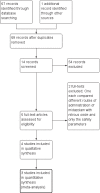Nitrous Oxide and Midazolam Sedation: A Systematic Review and Meta-Analysis
- PMID: 28604098
- PMCID: PMC5467758
- DOI: 10.2344/anpr-63-03-06
Nitrous Oxide and Midazolam Sedation: A Systematic Review and Meta-Analysis
Abstract
Nitrous oxide and midazolam have been used as sedative agents to decrease fear and anxiety associated with dental procedures. Although these agents have been widely used individually, the combination of the two is also commonly used. Four clinical trials were identified that compared the combination technique with the individual use of the drugs. The standardized mean difference (SMD) for each outcome measure was considered for final analysis. Three studies with 534 participants were included in the final meta-analysis, and the SMD [95% CI] was obtained as -0.15 [-0.32, 0.03] and was not statistically significant for cooperation scores. Two studies reported the dose of midazolam required for inducing sedation in 450 participants, and the pooled estimate of SMD [95% CI] was obtained as -0.29 [-0.48, -0.10] and was significant. Two studies with 450 participants reported the time taken to recover from sedation, and the pooled estimate of SMD [95% CI] was obtained as -0.20 [-0.39, -0.01] and favored the combination technique. To conclude, the combination technique combines the pros and cons of both drugs in causing fewer adverse effects due to midazolam by reducing the total dose and also helps to provide better acceptance of nitrous oxide inhalation.
Keywords: Dental anxiety; Midazolam; Nitrous oxide; Sedation.
Conflict of interest statement
The authors do not have any conflicts of interest.
Figures
Similar articles
-
Intravenous midazolam infusion for sedation of infants in the neonatal intensive care unit.Cochrane Database Syst Rev. 2003;(1):CD002052. doi: 10.1002/14651858.CD002052. Cochrane Database Syst Rev. 2003. Update in: Cochrane Database Syst Rev. 2012 Jun 13;(6):CD002052. doi: 10.1002/14651858.CD002052.pub2. PMID: 12535424 Updated.
-
Chloral hydrate as a sedating agent for neurodiagnostic procedures in children.Cochrane Database Syst Rev. 2017 Nov 3;11(11):CD011786. doi: 10.1002/14651858.CD011786.pub2. Cochrane Database Syst Rev. 2017. Update in: Cochrane Database Syst Rev. 2021 Aug 16;8:CD011786. doi: 10.1002/14651858.CD011786.pub3. PMID: 29099542 Free PMC article. Updated.
-
Intravenous midazolam infusion for sedation of infants in the neonatal intensive care unit.Cochrane Database Syst Rev. 2000;(2):CD002052. doi: 10.1002/14651858.CD002052. Cochrane Database Syst Rev. 2000. Update in: Cochrane Database Syst Rev. 2003;(1):CD002052. doi: 10.1002/14651858.CD002052. PMID: 10796280 Updated.
-
Current methods of sedation in dental patients - a systematic review of the literature.Med Oral Patol Oral Cir Bucal. 2016 Sep 1;21(5):e579-86. doi: 10.4317/medoral.20981. Med Oral Patol Oral Cir Bucal. 2016. PMID: 27475684 Free PMC article.
-
Chloral hydrate as a sedating agent for neurodiagnostic procedures in children.Cochrane Database Syst Rev. 2021 Aug 16;8(8):CD011786. doi: 10.1002/14651858.CD011786.pub3. Cochrane Database Syst Rev. 2021. PMID: 34397100 Free PMC article.
Cited by
-
Evaluating the Quality of Systematic Reviews on Pediatric Sedation in Dentistry: An Umbrella Review.J Clin Med. 2024 Jun 17;13(12):3544. doi: 10.3390/jcm13123544. J Clin Med. 2024. PMID: 38930074 Free PMC article. Review.
-
Current status of nitrous oxide use in pediatric patients.World J Clin Pediatr. 2022 Mar 9;11(2):93-104. doi: 10.5409/wjcp.v11.i2.93. eCollection 2022 Mar 9. World J Clin Pediatr. 2022. PMID: 35433304 Free PMC article. Review.
-
Ultra-Low Frequency TENS as an Adjunctive Therapy for Pain Management in Non-Surgical Periodontal Treatment: A Pilot Study.Dent J (Basel). 2025 Apr 9;13(4):161. doi: 10.3390/dj13040161. Dent J (Basel). 2025. PMID: 40277491 Free PMC article.
-
Success rate of nitrous oxide-oxygen procedural sedation in dental patients: systematic review and meta-analysis.J Dent Anesth Pain Med. 2021 Dec;21(6):527-545. doi: 10.17245/jdapm.2021.21.6.527. Epub 2021 Nov 26. J Dent Anesth Pain Med. 2021. PMID: 34909471 Free PMC article. Review.
-
Trends of conscious sedation in the Department of Pediatric Dentistry at the Dankook University Dental Hospital for 11 Years.J Dent Anesth Pain Med. 2023 Oct;23(5):265-271. doi: 10.17245/jdapm.2023.23.5.265. Epub 2023 Sep 27. J Dent Anesth Pain Med. 2023. PMID: 37841516 Free PMC article.
References
-
- Locker D, Shapiro D, Liddell A. . Negative dental experiences and their relationship to dental anxiety. Community Dent Health. 1996; 13: 86– 92. - PubMed
-
- Humphris G, King K. . The prevalence of dental anxiety across previous distressing experiences. J Anxiety Disord. 2011; 25: 232– 236. - PubMed
-
- Craig DC, Wildsmith JA. . Conscious sedation for dentistry: an update. British Dent J. 2007; 203: 629– 631. - PubMed
-
- Hosey MT, . UK National Clinical Guidelines in Pediatric Dentistry. Managing anxious children: the use of conscious sedation in paediatric dentistry. Int J Paediatr Dent. 2002; 12: 359– 372. - PubMed
Publication types
MeSH terms
Substances
LinkOut - more resources
Full Text Sources
Other Literature Sources
Miscellaneous





